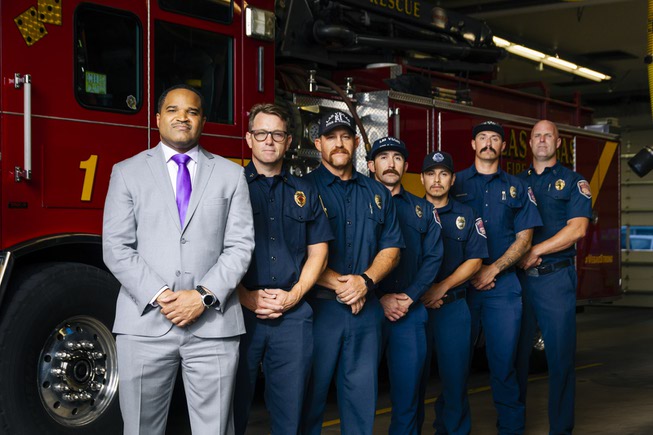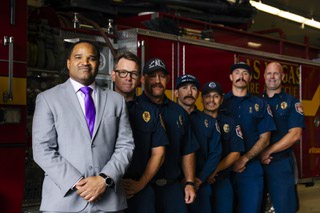
From left, Las Vegas Fire & Rescue Chief Fernando Gray, Battalion Chief Mike Thom, Fire Engineer Kelly Brinkerhoff, Fire Fighter Paramedic Alex De La Barcena, Firefighter Salvador Lopez, Firefighter Dylan Johnson and Fire Captain Ben Penick pose for a photo at Fire Station 1, downtown, Wednesday, July 27, 2022.
Monday, Aug. 1, 2022 | 2 a.m.
If you know anything about Fernando Gray’s credentials, you’ll immediately feel like something is out of place upon stepping into his office.
Gray, 50, got the green light last month from the City Council to become Las Vegas’ newest fire chief, and he brings a wealth of experience and certifications with him. Among them: He received his undergraduate degree from Texas A&M University and earned a masters of public administration from Sam Houston State University.
But even beyond his collegiate degrees, Gray is an alumnus of the Naval Post-Graduate School’s Executive Leaders Program and the Harvard Kennedy School’s Senior Executives Program. Additionally, he graduated from the National Fire Academy’s Executive Fire Officer Program, and obtained Chief Fire Officer Designation from the Center for Public Safety Excellence.
Inside his office, however, the walls are bare. It’s furnished with nothing more than a desk, a computer and a few chairs. That’s partially because he’s so new to the job that he’s barely had time to move any personal effects into his office, but it’s also because that’s just who he is.
“Each and every course or credential or certification that I’ve pursued, it’s been for one reason, and it’s to increase my capability to serve,” Gray said. “Not so much to decorate an office, not so much to show any kind of impressive résumé.
“What it’s about is how can I make sure that I am as impactful as possible? Those things are important because at the end of the day, it gives you more of a holistic look at how to deal with situations that the fire service is encountering.”
Gray grew up in Dallas and worked for the city’s fire department for 21 years. In that time, Gray said, he worked in a variety of roles ranging from firefighter and paramedic to lieutenant and battalion chief, rising all the way to the department’s second-in-command spot before leaving to be the fire chief in Aurora, Colo., in 2017.
From the time Gray was a child, he had his sights set on becoming a firefighter, he said. He remembers going to the nearest fire station to get some help pumping a bike tire, or playing catch with firefighters in the area.
And he hopes to bring that approach — engaging in the community — to his tenure in Las Vegas.
“One of the things that you might not know about Dallas is it’s really closely aligned from a service standpoint with the City of Las Vegas,” Gray said. “So that’s one of the things that was very appealing to me is to come back to my roots, so to speak, to an organization that is very similar to where I grew up.”
The Sun sat down with Gray for an exclusive interview about and what he hopes to accomplish in his tenure with Las Vegas Fire & Rescue. His comments have been edited for brevity and clarity:
What did you know about Las Vegas before accepting the job?
I’ve been to Vegas many times before. Not to gamble, I’m not a gambler. But I will say that, if you don’t know, this department is internationally known.
This is an outstanding department, and ... all the services that we provide, not just fire and EMS, but ... we actually do the dispatching for most of the county. The bomb squad services provided for this region are provided by Las Vegas Fire & Rescue. So there’s a lot of great things about this organization.
What I’m doing now is trying to make sure every member of this organization knows my leadership intent. Talking to them about values, direction, vision, where we’re going. I’m just really excited to be here, excited about what this organization is doing now, but also more excited about the future of the department.
How did you get your start in firefighting? Was there a particular reason you found yourself in that line of work?
That’s a great story: So one of the things that I will say is that the Dallas Fire Department, culturally, was based upon something that’s a passion point for me and something that I really want to enhance in Las Vegas, and that’s community engagement.
One of the things as a child, if there was something wrong with my bicycle — for example if it needed air in the tire — you would go to the fire station. I remember times my brother and I were playing football in the street and one of the firefighters would say “Give me the ball, go long!”
So just them showing that interest in me is something that always made me want to be a firefighter. I would say probably from the time I was 12 years old I wanted to be a firefighter, and not just a firefighter, but a paramedic because that organization (DFD) actually started providing EMS services in the 1970s. I know in Vegas, we started doing transport around 2000, and it’s something that is a very big passion point for me and one of the reasons why I’m here.
You were fire chief in Aurora when police deployed a chokehold on Elijah McClain, the 23-year-old Black man, who died in 2019 a few days after the altercation. After being subdued by police, Aurora paramedics injected McClain with ketamine, a powerful sedative. What about that situation did you learn, and why is it important to keep in mind as the head of a major department?
Unfortunately, that situation and some events even when I was in Dallas, were things that are always an opportunity for us to learn from. I think one of the best things that I would say from any type of adverse situation you have is to make sure that you do after-action (reports), and also make sure that you’ve listened to the responses of the people.
So if people have concerns about the way you’re providing service, listen to them. Listen to them, and then make changes to make sure that subsequent events won’t happen like that in the future.
You were the first Black fire chief in Aurora, and you just touched a bit on how diversity is important to keep in mind while working with the community. Could you expand on your experience with diversity and why it’s important?
I did grow up in Dallas, Texas, in the South. And believe it or not, I grew up during a period where they actually had mandatory busing still going on, meaning that they were moving or actually having people from underrepresented neighborhoods basically bussed to other portions of the community to make sure the school district was diversified. I found a lot of value in that — the exposure to different ideas, the exposure to people from different backgrounds.
I wouldn’t be sitting in here without those opportunities. There have been a lot of firsts when you start talking about my outward appearance as a person of color. But my goal has always been not so much to be the first, but to make sure I’m not the last. And what I think is very important is to always remember that in order for me to get the opportunities I had, a lot of people had to invest in me. And some of that starts with what I told you a little bit earlier, about the firefighters in Dallas just showing an interest in a little kid in the neighborhood.
It seems like community engagement is a big pillar in what you stand for as a public official. How can you bring that to this job?
The first way is by clearly defining to each and every one of our members that that’s one of our pillars. And I was just over at Station 1 talking about that: We are going to be an organization that is values-driven, and one of those primary values is how we engage with the community. And not just a community in one section, but every portion of the community, including the unhoused, including people that perhaps might not have any other services that they can lean on. That’s going to be a group we’re going to make sure we reach out to, even more than our regular constituents.
Most people want police and fire departments to be active in the community, but can you put into words why that engagement is so important?
First of all, it’s a big part of our mission, to make sure we serve those that need our assistance. The second piece is that when you’re engaged with the community, it’s also a long-term strategy to make sure you are recruiting a diverse population.
So if you’re in every component of the community, you will end up getting a diverse group of people wanting to be a part of the department. That’s something that I strongly believe in. That’s the reason why community engagement is so important. And then the last thing is that when you engage with the community, those are our customers. And if we engage with them, we actually have a better understanding of what services they want, the services that they need, and also what they expect.
There have been a number of fires in unoccupied structures across the valley in recent months. Is that a priority on your radar?
There’s always value to being proactive. I haven’t been here long enough to know if that is an issue in this community.
I will say that there are processes that you can put into place. For example, making sure you have an accurate accounting of the buildings that are vacant. But to be quite honest, I don’t know if that is an issue or concern here.

